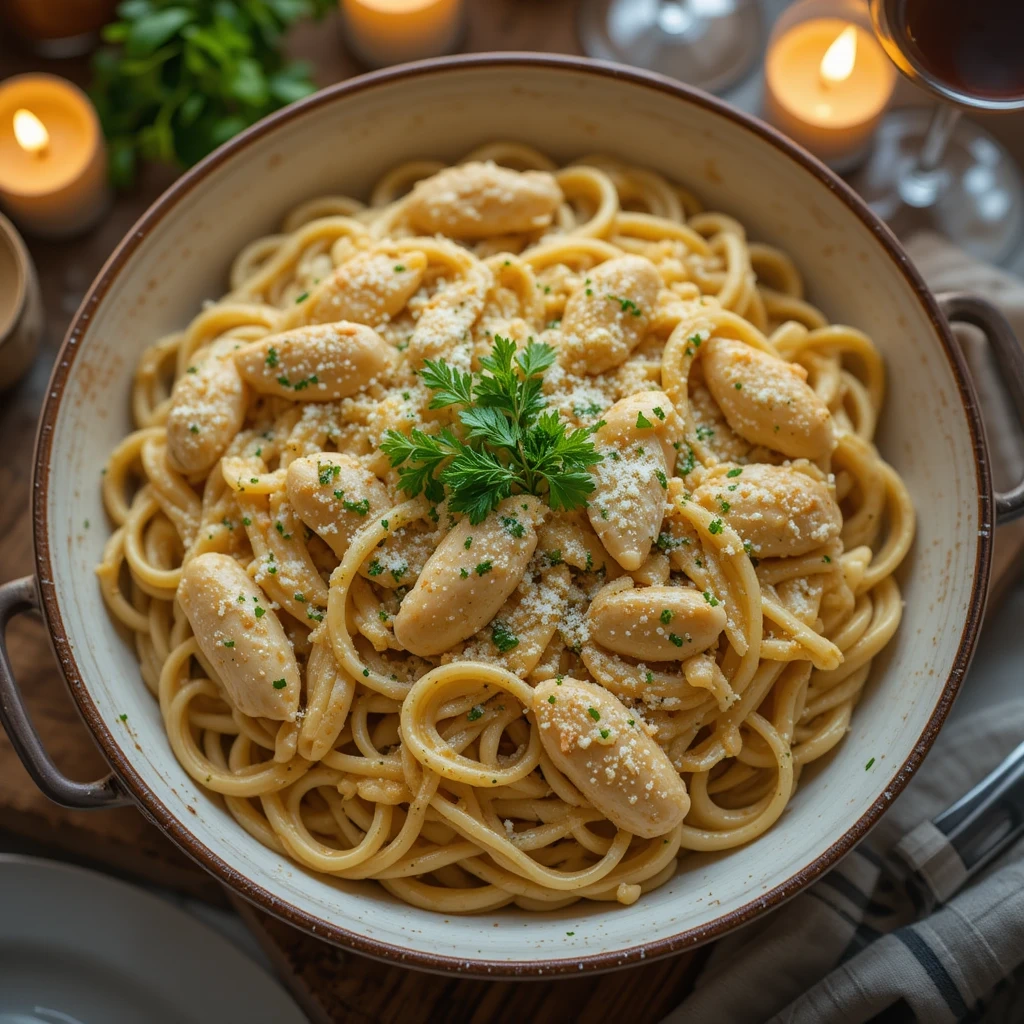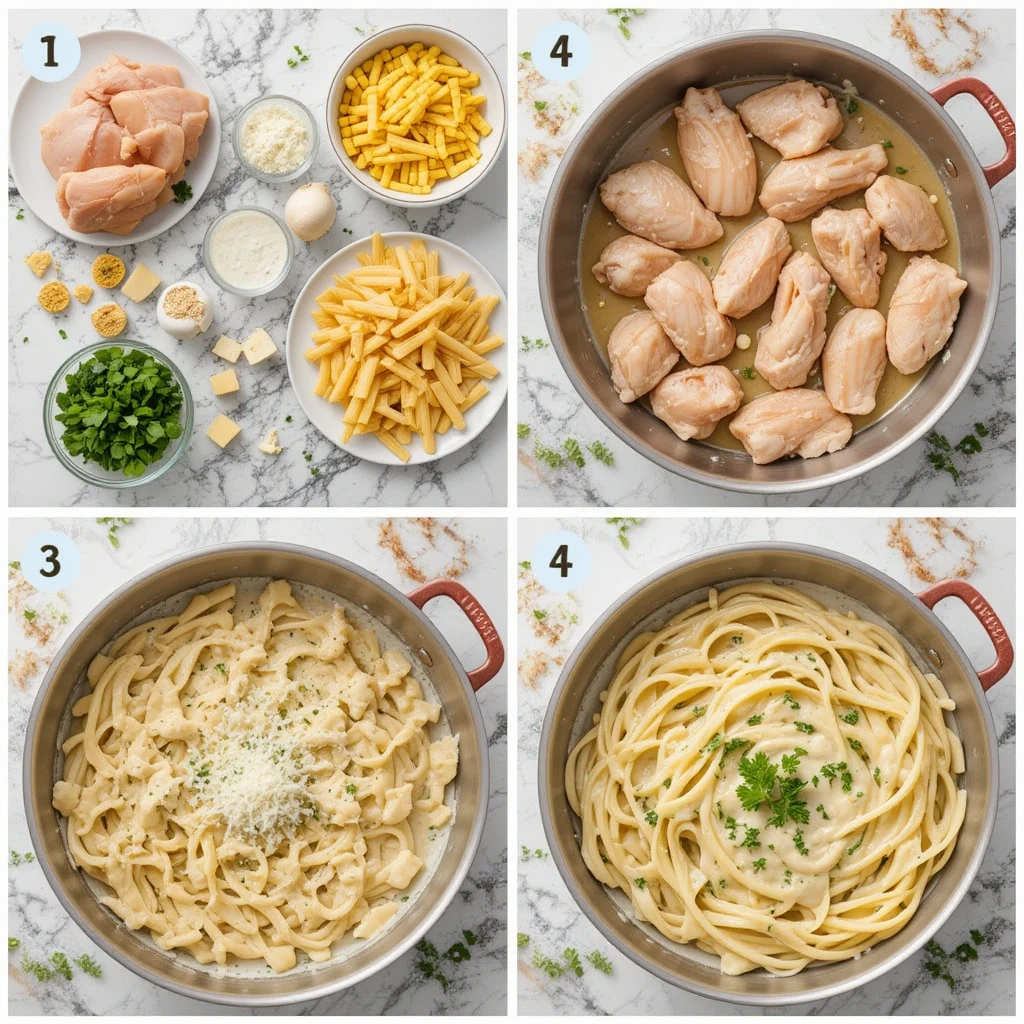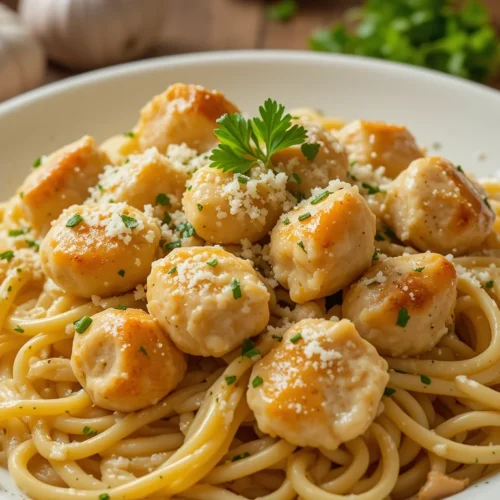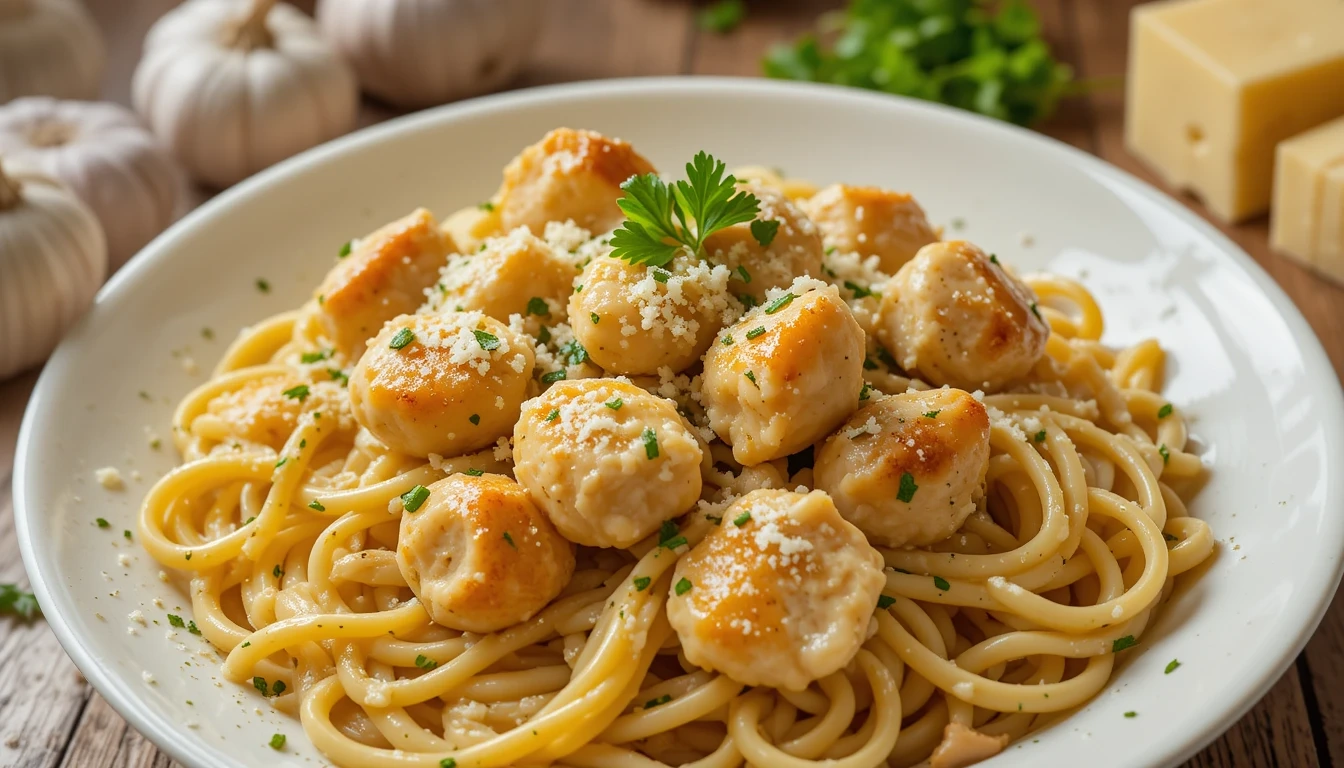Garlic Parmesan Chicken Pasta is a rich and comforting dish that brings together tender pieces of chicken, perfectly cooked pasta, and a creamy sauce infused with the bold flavors of garlic and Parmesan cheese. This classic combination creates a meal that is both satisfying and indulgent, making it a favorite for cozy family dinners or entertaining guests
Creamy Garlic Parmesan Chicken Pasta is a delectable and satisfying dish that combines tender chicken, al dente pasta, and a rich, creamy sauce infused with the flavors of garlic and Parmesan cheese. This dish is a perfect choice for a cozy dinner at home or for entertaining guests. The creamy texture and savory taste make it a popular favorite among pasta lovers.
The combination of garlic and Parmesan adds a depth of flavor that elevates this dish to a whole new level of culinary delight. This dish is a harmonious blend of protein, carbohydrates, and dairy, making it a well-rounded meal that is both comforting and indulgent. The creamy sauce coats the pasta and chicken, creating a luscious and satisfying bite with every forkful.
Whether you’re a fan of Italian cuisine or simply enjoy a hearty and flavorful meal, Creamy Garlic Parmesan Chicken Pasta is sure to please your palate and leave you feeling fully satisfied.
Table of Contents
How to Make the Perfect Creamy Garlic Parmesan Chicken Pasta
Cooking the Chicken and Pasta
Start by cooking the chicken in a skillet until it’s golden brown and cooked through. Then, set the chicken aside and prepare the pasta according to the package instructions.
Preparing the Creamy Sauce
In a separate pan, sauté minced garlic in butter until fragrant, then add heavy cream and grated Parmesan cheese, stirring until the sauce is smooth and creamy.
Assembling and Serving
Once the sauce is ready, add the cooked pasta and chicken to the pan, tossing everything together until well combined. For an extra burst of flavor, consider adding some fresh herbs such as parsley or basil to garnish the dish. The herbs not only add a pop of color but also contribute a refreshing aroma that complements the richness of the creamy sauce. Serve the Creamy Garlic Parmesan Chicken Pasta hot, allowing your guests to savor the delightful combination of flavors and textures in every mouthful.
eck out this delicious Chicken Broccoli Rice Casserole recipe on Veibrant Recipes! This easy, cheesy, and comforting dish is perfect for busy weeknights, combining tender chicken, nutritious broccoli, and creamy rice in a flavorful, oven-baked meal. It’s a family favorite that’s simple to prepare and packed with savory goodness. Get the full recipe here: Chicken Broccoli Rice Casserole
The Ultimate Comfort Food: Creamy Garlic Parmesan Chicken Pasta
Garlic Parmesan Chicken Pasta with a Creamy Sauce is the ultimate comfort dish.. The creamy sauce envelops each strand of pasta and every tender piece of chicken, creating a dish that warms both the body and soul. The combination of garlic and Parmesan infuses the dish with a comforting aroma that evokes feelings of home and contentment.
Whether enjoyed on a chilly evening or as a pick-me-up after a long day, this dish has the power to soothe and satisfy like no other. The creamy texture of the sauce, coupled with the savory notes of garlic and Parmesan, makes this dish a go-to option for those seeking solace in a bowl of pasta. The richness of the sauce provides a sense of indulgence, while the familiar flavors offer a sense of reassurance.
Creamy Garlic Parmesan Chicken Pasta is not just a meal; it’s a comforting embrace in the form of food.
Upgrade Your Pasta Dish with Creamy Garlic Parmesan Chicken
| Metrics | Data |
|---|---|
| Calories | 450 |
| Protein | 30g |
| Fat | 20g |
| Carbohydrates | 35g |
| Sodium | 800mg |
If you’re looking to take your pasta game to the next level, Creamy Garlic Parmesan Chicken Pasta is the answer. This dish offers a luxurious twist on traditional pasta recipes, combining the classic flavors of garlic and Parmesan with tender pieces of chicken for a truly indulgent experience. The creamy sauce adds a velvety richness to the dish, elevating it from a simple pasta meal to a gourmet delight.
By incorporating chicken into the pasta dish, you not only enhance its protein content but also introduce an additional layer of flavor and texture. The succulent chicken pairs perfectly with the creamy garlic Parmesan sauce, creating a symphony of tastes that will impress even the most discerning palates. Whether you’re hosting a dinner party or simply treating yourself to a special meal, Creamy Garlic Parmesan Chicken Pasta is an excellent choice for those looking to elevate their pasta game.

And don’t forget to stay tuned for more great meal ideas! I’ll be sharing plenty of delicious recipes that will inspire you to get creative in the kitchen, so keep checking back for more fun twists on your favorite dishes. Until then, happy cooking, and I can’t wait to see how you make this dish your own!
https://therecipecritic.com/crockpot-parmesan-garlic-chicken-pasta
Creamy Garlic Parmesan Chicken Pasta: A Crowd-Pleasing Dish
When it comes to pleasing a crowd, Creamy Garlic Parmesan Chicken Pasta is a surefire winner. Its rich and creamy sauce, combined with tender pieces of chicken and perfectly cooked pasta, makes it an irresistible option for gatherings and events. Whether you’re hosting a family dinner or a potluck with friends, this dish is guaranteed to receive rave reviews and leave everyone coming back for seconds.
The versatility of Creamy Garlic Parmesan Chicken Pasta also makes it an ideal choice for feeding a large group. It can be easily scaled up to accommodate more servings without compromising on flavor or quality. Additionally, its universal appeal ensures that even picky eaters will find something to love in this crowd-pleasing dish.
With its winning combination of flavors and textures, Creamy Garlic Parmesan Chicken Pasta is an excellent choice for any social gathering.

A Step-by-Step Guide to Creating Creamy Garlic Parmesan Chicken Pasta
Prepare the Chicken and Pasta
To create Creamy Garlic Parmesan Chicken Pasta, start by cooking seasoned chicken breast in a skillet until golden brown and fully cooked.Put the chicken to the side and prepare your preferred pasta following the directions on the package.
Make the Garlic Cream Sauce
In a separate pan, sauté minced garlic in butter until fragrant, then pour in heavy cream and grated Parmesan cheese, stirring until the sauce is smooth and creamy.
Combine and Serve
When the sauce is prepared, incorporate the cooked pasta and chicken into the pan, mixing thoroughly until everything is well blended. Garnish with freshly chopped parsley or basil for an extra burst of flavor and serve hot.
Enjoy Your Delicious Dish
This step-by-step guide ensures that you can easily recreate this delicious dish in your own kitchen, allowing you to enjoy its comforting flavors whenever the craving strikes.

5 Typical Blunders to Avoid and Their Remedies
When preparing Creamy Garlic Parmesan Chicken Pasta, there are several common mistakes that can detract from the dish’s overall quality. One common error is overcooking the chicken, which can result in dry and tough meat. To avoid this, be sure to cook the chicken just until it’s no longer pink in the center, then remove it from the heat to prevent overcooking.
Another mistake to watch out for is using too much heat when making the creamy sauce. If the sauce is exposed to high temperatures, it might curdle or break apart, resulting in a texture that is not visually pleasing. To prevent this, keep the heat at a moderate level and stir the sauce constantly as it cooks.
Additionally, using pre-grated Parmesan cheese instead of freshly grated can lead to a less flavorful sauce. Freshly grated Parmesan cheese has a superior taste and melts more smoothly into the sauce, so it’s worth taking the extra step to grate it yourself. Furthermore, overcooking the pasta can lead to a mushy texture, so be sure to follow the package instructions for cooking times and test for doneness before draining.
Lastly, not seasoning the dish adequately can result in bland flavors. Be sure to taste and adjust the seasoning as needed with salt and pepper to enhance the overall taste of the dish. By avoiding these common mistakes and following these solutions, you can ensure that your Creamy Garlic Parmesan Chicken Pasta turns out perfectly every time.
FAQs
What is Creamy Garlic Parmesan Chicken Pasta?
This favorite dish, Creamy Garlic Parmesan Chicken Pasta, blends juicy chicken with al dente pasta and a luscious garlic parmesan sauce. It is a comforting and flavorful meal that is easy to make and perfect for a cozy night in.
What are the usual components of Creamy Garlic Parmesan Chicken Pasta?
Common ingredients for Creamy Garlic Parmesan Chicken Pasta include chicken breast, pasta (such as fettuccine or penne), garlic, butter, heavy cream, chicken broth, parmesan cheese, and seasonings such as salt, pepper, and Italian herbs.
How do you make Creamy Garlic Parmesan Chicken Pasta?
To make Creamy Garlic Parmesan Chicken Pasta, you typically start by cooking the chicken until it is golden and cooked through. Then, you prepare the creamy garlic parmesan sauce by sautéing garlic in butter, adding heavy cream and chicken broth, and then stirring in parmesan cheese until it melts into a smooth sauce. The cooked pasta and chicken are then added to the sauce and tossed to combine.
What are some common mistakes to avoid when making Creamy Garlic Parmesan Chicken Pasta?
Some common mistakes to avoid when making Creamy Garlic Parmesan Chicken Pasta include overcooking the chicken, not seasoning the dish adequately, using too much or too little sauce, overcooking the pasta, and not properly emulsifying the sauce.
Can you list some variations of Creamy Garlic Parmesan Chicken Pasta?
Variations of Creamy Garlic Parmesan Chicken Pasta can include adding vegetables such as spinach, sun-dried tomatoes, or mushrooms, using different types of pasta, incorporating bacon or pancetta for added flavor, or adding a touch of heat with red pepper flakes.
Is Creamy Garlic Parmesan Chicken Pasta a crowd-pleasing dish?
Yes, Creamy Garlic Parmesan Chicken Pasta is often considered a crowd-pleasing dish due to its rich and comforting flavors. It is a popular choice for family dinners, gatherings, and potlucks.

garlic parmesan chicken pasta
Ingredients
- Chicken breast
- Pasta fettuccine or penne
- Garlic
- Butter
- Heavy cream
- Parmesan cheese
- Salt
- Pepper
- Italian herbs optional
- Chicken broth optional
- Pros:
- Crowd-pleasing dish
- Comforting and flavorful
- Relatively easy to make
- Can be customized with vegetables or other additions
- Good balance of protein carbs, and dairy
- Cons:
- Can be high in calories and fat
- Requires careful attention to cooking times to avoid overcooking chicken or pasta
- Sauce can curdle if overheated
Instructions
- Cook seasoned chicken breast in a skillet until golden brown and fully cooked. Set aside.
- Prepare pasta according to package directions.
- In a separate pan, sauté minced garlic in butter until fragrant.
- Pour in heavy cream and grated Parmesan cheese, stirring until the sauce is smooth and creamy. Add chicken broth if desired.
- Incorporate the cooked pasta and chicken into the pan, mixing thoroughly until everything is well blended.
- Garnish with freshly chopped parsley or basil (optional).
- Serve hot and enjoy.


2 thoughts on “5 Easy Garlic Parmesan Chicken Pasta Recipes You Need to Try”